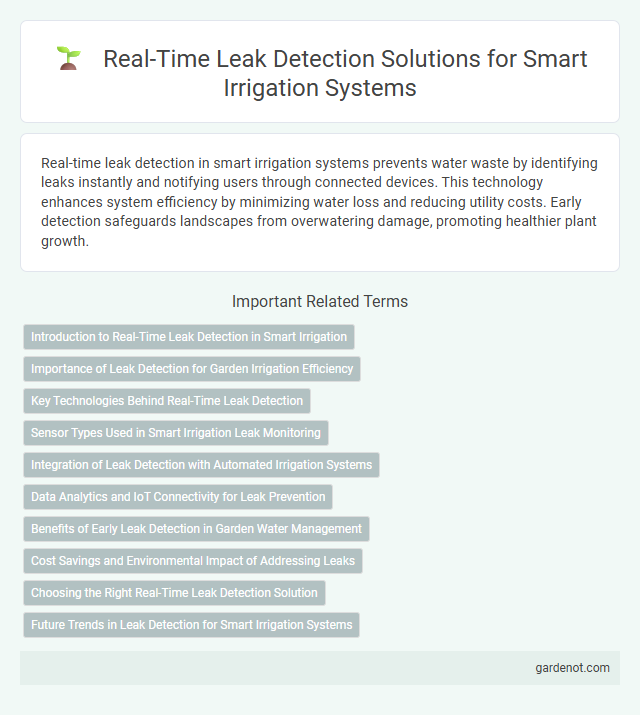Real-time leak detection in smart irrigation systems prevents water waste by identifying leaks instantly and notifying users through connected devices. This technology enhances system efficiency by minimizing water loss and reducing utility costs. Early detection safeguards landscapes from overwatering damage, promoting healthier plant growth.
Introduction to Real-Time Leak Detection in Smart Irrigation
Real-time leak detection in smart irrigation utilizes advanced sensors and IoT technology to continuously monitor water flow and pressure, identifying anomalies that indicate leaks instantly. This system significantly reduces water waste by triggering immediate alerts and automated shut-offs, enhancing irrigation efficiency and sustainability. Integrating real-time leak detection improves water conservation efforts, lowers operational costs, and supports eco-friendly agricultural practices.
Importance of Leak Detection for Garden Irrigation Efficiency
Real-time leak detection in garden irrigation systems is crucial for maintaining water efficiency and preventing resource waste. Early identification of leaks reduces water loss, lowers utility bills, and promotes healthier plant growth by ensuring consistent moisture levels. Implementing smart sensors enables proactive maintenance, extending the lifespan of irrigation infrastructure and supporting sustainable gardening practices.
Key Technologies Behind Real-Time Leak Detection
Real-time leak detection in smart irrigation leverages advanced sensor technologies, including soil moisture sensors and acoustic leak detectors, to identify anomalies in water flow and pressure instantly. IoT-enabled devices connect these sensors to cloud-based analytics platforms, enabling continuous monitoring, data processing, and immediate alerts for leak identification. Machine learning algorithms enhance detection accuracy by analyzing historical and real-time data to differentiate between normal irrigation patterns and leaks.
Sensor Types Used in Smart Irrigation Leak Monitoring
Smart irrigation systems utilize advanced sensors such as ultrasonic flow meters, pressure sensors, and soil moisture probes to enable real-time leak detection, ensuring efficient water use and preventing wastage. Ultrasonic flow meters monitor flow rates by measuring sound waves, identifying anomalies indicative of leaks. Pressure sensors detect sudden drops in water pressure within the irrigation network, while soil moisture probes track unexpected moisture levels beneath the surface, together forming a comprehensive leak monitoring framework.
Integration of Leak Detection with Automated Irrigation Systems
Real-time leak detection integrated with automated irrigation systems significantly enhances water efficiency by promptly identifying leaks and triggering automatic shutoff mechanisms. This integration leverages sensors and IoT technology to monitor soil moisture, pressure, and flow rates, ensuring precise water distribution while minimizing waste. Advanced analytics within these systems enable predictive maintenance, reducing the risk of extensive damage and optimizing irrigation schedules for sustainable water management.
Data Analytics and IoT Connectivity for Leak Prevention
Real-time leak detection in smart irrigation leverages IoT sensors to continuously monitor water flow and pressure, enabling immediate identification of anomalies that indicate leaks. Advanced data analytics algorithms process this sensor data to predict potential leak points and prevent water wastage by triggering automated alerts or system shutdowns. Integrating IoT connectivity ensures seamless communication between devices and centralized control systems for proactive leak management.
Benefits of Early Leak Detection in Garden Water Management
Early leak detection in smart irrigation systems minimizes water waste by promptly identifying and addressing leaks, leading to significant water conservation. Timely repairs prevent damage to garden plants and soil structure, maintaining optimal growing conditions and enhancing plant health. Real-time monitoring also reduces utility costs and supports sustainable water management practices, ensuring efficient irrigation system performance.
Cost Savings and Environmental Impact of Addressing Leaks
Real-time leak detection in smart irrigation systems significantly reduces water waste by identifying and addressing leaks immediately, leading to substantial cost savings on water bills. Efficient leak management minimizes unnecessary water usage, lowering energy consumption associated with water pumping and treatment. This proactive approach not only conserves valuable water resources but also reduces the environmental footprint of irrigation practices, promoting sustainable agriculture.
Choosing the Right Real-Time Leak Detection Solution
Selecting the right real-time leak detection solution for smart irrigation systems hinges on sensors with high sensitivity and rapid response capabilities to minimize water loss. Advanced technologies like acoustic sensors, soil moisture probes, and flow meters integrated with IoT platforms enable immediate alerts and precise localization of leaks. Prioritizing scalability and compatibility with existing irrigation infrastructure ensures seamless monitoring and efficient water management.
Future Trends in Leak Detection for Smart Irrigation Systems
Real-time leak detection in smart irrigation systems is evolving with the integration of advanced IoT sensors and machine learning algorithms that provide continuous monitoring and instant anomaly identification. Future trends emphasize the use of AI-driven predictive analytics to not only detect leaks but also forecast potential pipeline failures, enhancing water conservation efforts. Emerging technologies like blockchain ensure secure data sharing across irrigation networks, promoting transparency and efficient leak management in smart agriculture.
Real-time leak detection Infographic

 gardenot.com
gardenot.com